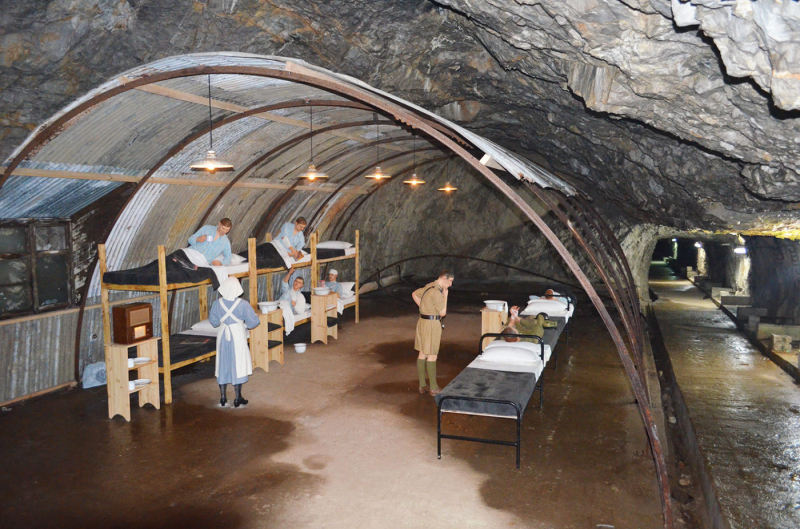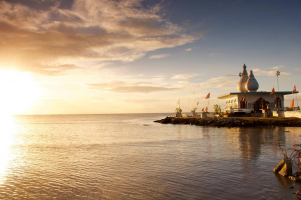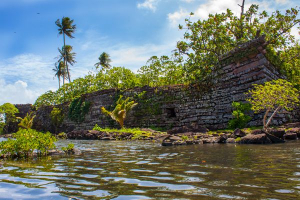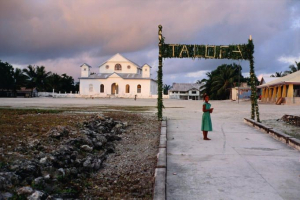Top 7 Most Beautiful Historical Sites in Gibraltar (UK)
Gibraltar has been a British Overseas Territory since 1713, when it was taken during the War of Spanish Succession. It is known as the "key to the ... read more...Mediterranean." The "Rock of Gibraltar," as it's still known, rises out of the sea on the east side of Algeciras Bay and is connected to mainland Spain by a narrow isthmus near the southern tip of the Iberian Peninsula, overlooking one of the world's busiest shipping lanes. Despite its small area, this territory also has a long history of fighting foreign invaders, so there are still many outstanding historical places. Today, let's follow Toplist to discover the most beautiful historical sites in Gibraltar
-
Europa Point is Gibraltar's southernmost point (the southernmost point of the Iberian Peninsula being Punta de Tarifa 25 km southwest of Gibraltar). Europa Point, at the southernmost tip of the peninsula, is at the doorway between the Mediterranean and the Atlantic, offering a glimpse of Africa on a clear day.
Apart from the scenic views of Moroccan mountains and Spanish coastal towns, the Harding's Battery, the Ibrahim-al-Ibrahim Mosque, the Roman Catholic Shrine of Our Lady of Europe, the Europa Point Lighthouse, and the Nun's Well are all noteworthy structures in this area. Europa Point is also home to Gibraltar's only dedicated cricket oval, where the Gibraltar national cricket team competes, and the Sikorski Memorial, which has been in place since 2013.
Governor Sir Alexander Woodford built the Europa Point Lighthouse between 1838 and 1841. In February 1994, it became fully automated, and its loom can be seen from a distance of 27 kilometers (17 mi). It is Trinity House's southernmost lighthouse, as well as the only one outside the United Kingdom.The King Fahd bin Abdulaziz al-Saud Mosque, commonly known as the Mosque of the Custodian of the Two Holy Mosques, is a mosque in Europa Point. The structure was a gift from Saudi Arabia's King Fahd and took two years to construct at a cost of roughly £5 million. It was opened to the public on August 8, 1997. A school, library, and lecture hall are all part of the mosque complex. It is Gibraltar's only purpose-built mosque, serving the territory's Muslim population of over 1,000 people.
And there is much more to be discovered in this Europa Point. Enrich your experience by coming here and asking the locals about the places, you will surely learn a lot of new things.
Location: Europa Point, Gibraltar

Photo: inspirock 
Photo: inspirock -
The Upper Galleries, also known as the Great Siege Tunnels, are a network of tunnels inside the northern end of the Rock of Gibraltar in the British Overseas Territory of Gibraltar. During the late-eighteenth-century Great Siege of Gibraltar, the British excavated them out of solid limestone.
The garrison's requirement to cover a blind angle on the northeast side of the Rock prompted the construction of the tunnels. The only way to cover that aspect was to use a gun positioned on The Notch, a rocky outcropping. Because there was no way to build a roadway there due to the sheer cliff face, Military Artificers Sergeant-Major Henry Ince proposed digging a tunnel. On May 25, 1782, his idea was approved, and construction work began.
The tunnels were carved out of the limestone rock by hand, using a sledgehammer, a crowbar, and gunpowder. The cannon gun holes were originally created for a different purpose (as air vents), but their potential was quickly realized, and the tunnels quickly became gun emplacements. There are dioramas representing miners at labor and soldiers under siege, as well as some actual Victorian armaments.The tunnel was only 82 feet long at first, but by the end of WWII, when diamond drills and better tunneling methods were available, the tunnels had grown to more than thirty miles in length, winding and turning as they went. The visitor to the Great Siege Tunnels today will notice that they seem to go on forever, and that you can enter on one side of Gibraltar and end up almost on the opposite side of the Rock.
Location: 1b Leanse Place, Gibraltar GX11 1AA, Gibraltar

Photo: inspirock 
Photo: inspirock -
The largest of the two main squares in Gibraltar's city center is Grand Casemates Square (the other being John Mackintosh Square). The square is named after the Grand Casemates, a casemate and bombproof barracks erected by the British and finished in 1817 at the square's northern end.
Grand Casemates Square, which is as old as the city itself, is Gibraltar's nightlife and commercial core, with a plethora of pubs, restaurants, clubs, and stores. On the street's northern terminus, bombproof barracks now house a café and an art gallery. The land was cleared and transformed into an esplanade after the Great Siege, which held military parades and public hangings (the last of which occurred in 1864). Notice the excavated foundations of a 14th-century galley house that was built in the Moorish period but sank into the sand over the years.
One of the chief attractions at Casemates Square is the Ceremony of the Keys. It is a re-enactment of the locking of the gates that lead to the old Gibraltar garrisons. Like its counterpart in London, the Ceremony of the Keys carries on the tradition that history is not dull but a living part of life. The ceremony is performed once a year courtesy of the Royal Gibraltar Regiment and re-enacted every Saturday at noon by the Gibraltar Re-enactment Association. Perhaps that only adds to the mystery and attraction of the Casemate area, the ghosts of the people who fought and died for this lonely bit of the strategic ground.Grand Casemates Square, where you may eat, drink, shop, and reflect on great history, will leave you with unforgettable memories. It's a hive of activity all year round, with enduring traditions and first-rate entertainment for all ages. It is considered one of the most beautiful historical sites in Gibraltar, and certainly, it is a must-see during your trip to this area.
Location: Gibraltar

Photo: inspirock 
Photo: inspirock -
Mediterranean Steps is a nature route and path in Gibraltar, a British Overseas Territory. The path, which runs entirely within the Upper Rock Nature Reserve and was built by the British military but is now used by civilians as a pedestrian route connecting Martin's Path and Lord Airey's Battery near the summit of the Rock of Gibraltar, is one of Gibraltar's footpaths. Windmill Hill, Europa Point, the Great Sand Dune, Gibraltar's east side beaches, the Mediterranean Sea, and the Spanish Costa del Sol are all visible from the path.
The Mediterranean Steps were originally constructed as part of the British military communications system to give access to their different defense installations at the southern end of the Rock. The two 9.2-inch guns of Lord Airey's Battery and O'Hara's Battery are located at the top of the steps. Along the way, more World War II-era gun emplacements and associated structures can be seen.
The Goat's Hair Twin Caves can be viewed along the way, and the trail is wholly within the Upper Rock Nature Reserve. These caves have signs of being sea caves when the sea level was significantly higher. These are just a few of Gibraltar's caverns that have yielded evidence of prehistoric human settlement.
Climb Mediterranean Steps, the area's secret jewel, to learn about the plant and animal life of the Rock of Gibraltar while taking in magnificent sights. This undeveloped road meanders around the rock's eastern face, passing through a natural reserve, natural caverns, and World War II bunkers.
This historic site is now open to the public for tours. The greatest time to visit is in the spring, when the sun hasn't reached its peak and the weather is still pleasant, with temperate days and pleasant evenings.
Location: 4MG4+2H8, Ohara's Rd, Gibraltar GX11 1AA, Gibraltar

Photo: commons.wikimedia.org 
Photo: lifetour -
The Trafalgar Cemetery is located in Gibraltar, a British Overseas Territory. It used to be known as the Southport Ditch Cemetery, and it is located immediately south of the city walls, in what used to be a defensive ditch during the Spanish administration of Gibraltar.
The cemetery was abandoned for many years and was renovated in the 1980s, however it is no longer utilized for burials. A memorial to the Battle of Trafalgar was built in the cemetery in 1992. On Trafalgar Day, the Sunday closest to the anniversary of the Battle of Trafalgar, the graveyard hosts an annual memorial service. The Gibraltar Heritage Trust has listed Trafalgar Cemetery.
Although it is named after the Battle of Trafalgar, which took place on October 21, 1805, just two of the battle's casualties are buried there. The rest of the interments are for people who died in subsequent maritime conflicts or as a result of the yellow fever epidemics that devastated Gibraltar between 1804 and 1814. In addition, tombstones from St. Jago's Cemetery and Alameda Gardens were moved to the Trafalgar Cemetery.
There are several intriguing stones that remember those who are buried there, as well as some that remind us of past dangers and those who died in horrific epidemics. Don't forget to include Trafalgar Cemetery among the most intriguing and unusual attractions of Gibraltar on your list of things to see when visiting the Rock.Location: 4JMW+WW9, Gibraltar GX11 1AA, Gibraltar

Photo: gibraltarheritagetrust 
Photo: inspirock -
With Italy's admission into the war and Germany's dominance of Europe, Gibraltar's strategic importance expanded. The need for storage became urgent and critical; space became even more important; stocks, food, and equipment had to be built up and safeguarded; and troops needed siege accommodation. A tunnel system would fit these requirements, providing complete protection from all known types of aviation strikes as well as marine and land bombardment at the time.
The civilian population was evacuated at the outset of the war, and the garrison was considerably expanded. Several more tunnels were dug to accommodate the growing garrison and to store massive amounts of food, equipment, and ammunition. The tunnels were built by four specialized tunneling units from the Royal Engineers and the Canadian Army during World War II.
A new Main Base Area was built on the Mediterranean coast in the south-eastern part of Gibraltar, shielded from the potentially hostile Spanish mainland, and new connecting tunnels were built to connect it to the existing military bases on the west side. To connect the bulk of the wartime tunnels, the Great North Road and the Fosse Way tunnels were excavated nearly the whole length of the Rock.The World War II Tunnels housed what amounted to a mini-city underground. The whole 16,000-strong garrison, as well as enough food to sustain them 16 months, could be held there. A subterranean telephone exchange, a power generating station, a water distillation plant, a hospital, a bakery, ammunition magazines, and a vehicle repair facility were all located within the tunnels. The complete tunnel network within the Rock is approximately 34 miles (55 kilometers) long.
A licensed tour guide will lead you on a 30- to 40-minute tour of the World War II Tunnels, which will include static exhibitions and photographic displays. The tunnels' structure will undoubtedly astound you.Location: 4MV2+P9M, Willis's Rd, Gibraltar GX11 1AA, Gibraltar

Photo: gibraltarinfo.gi 
Photo: tripadvisor -
The Tower of Homage and the Gate House are the most prominent components of the Moorish Castle, which is a medieval stronghold in Gibraltar that consists of different buildings, gates, and defended walls. The Gibraltar prison was situated in part of the castle until it was relocated in 2010.
The Moorish Castle Complex (The Tower of Homage and The Gate House), a contemporary of the more famous Alhambra, proudly shows the scars of countless sieges it has endured over the years. The castle's original fortifications were built around 1160, but the main tower, as well as the walls, gatehouse, and bastions, are from the 14th century, or the second Moorish period. From the exterior, you can readily study the castle's structure and absorb the medieval aura. Entering the tower provides little in the way of educational value: there are no displays and only a few historical facts that may be found elsewhere if you don't want to pay the entrance price.
All visitors to Gibraltar will notice the Tower of Homage, not only because of its spectacular architecture, but also because of its commanding and strategic position. Although it is often likened to Spain's Alcázar, Gibraltar's Moorish Castle was built by the Marinid dynasty, making it unique on the Iberian Peninsula.The Moorish Castle is now one of the most beautiful historical sites in Gibraltar and the most popular tourist attractions in this area, and it is depicted on the reverse of the Gibraltar five-pound banknote from 1995 (which is still in circulation). The term "Moorish Castle" is also applied to the residential area surrounding the Castle, which is where the Moorish Castle Estate is located.
Location: 5 Moorish Castle Estate, Gibraltar GX11 1AA, Gibraltar

Photo: hpb.co.uk 
Photo: tripadvisor




























